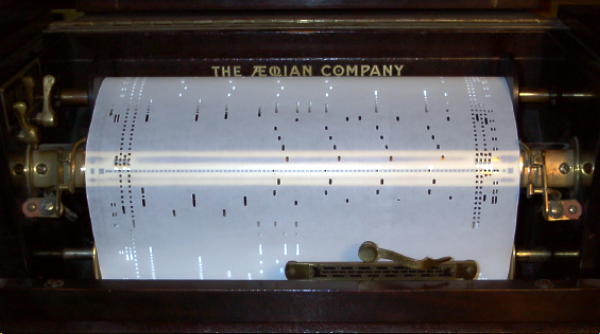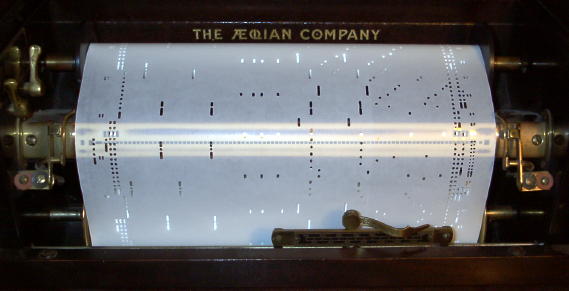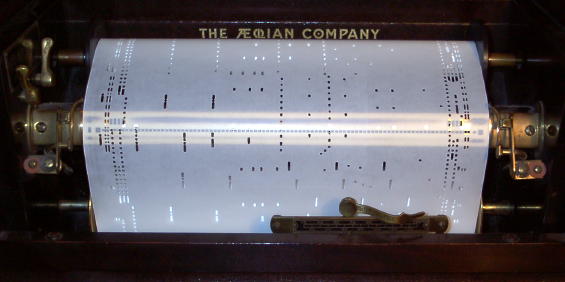
Photographic Page for ARTCRAFT Music Rolls:
"The TRUTH is in your SPOOLBOX!"
The commentary below should be read in tandem with Newsletter #5, which features a full description of HOW these rolls were arranged in the ARTCRAFT Studio ... and WHY.
If you aren't yet a subscriber to our Newsletter, published every couple of months and linked — in most cases — to the comprehensive texts, you can access this, and the previously published Newsletters, by going to http://artcraftrolls.listbot.com and then selecting VIEW LIST ARCHIVE for any of the issues already published within the past year. (Previous issues which are older will be posted on our own server, after May 1, 2001.)
Newsletter #5 is devoted to the topic of the 'duo-pianist' style of roll ... something which was botched repeatedly for about 50 years, and which was successfully simulated with the ARTCRAFT Interpretive Arranging process, developed in the mid-'Fifties by L. Douglas Henderson.
Below is a picture of the 1933 original roll of THE CARIOCA, as seen in the aperture of of the Steinway Duo-Art 'AR' grand in the Maine roll-arranging Studio. This Aeolian-American release was also available for the Ampico 'reproducing' player, featuring the same lackluster note-score and the B-style expression holes. Both versions were merely notation scores by Frank Milne, arranged on graph paper specially marked for the piano scale.
Note the "connected" perforations for the piano keys ... something which should never be played on a piano, when trying to convey the essence of sensual South American music. This gives an organ-like sound to a piece which should be bursting with staccato rhythms and pulsating with unexpected accents.
If you examine the marginal perforations, which operate the Duo-Art control levers, it's obvious that any Pianolist could add better expression. The hole on the FAR RIGHT triggers the Soft Pedal ... on THE CARIOCA??? The extended expression perforations on the FAR LEFT set the Accompaniment texture, which is "mezzo-piano" most of the time (that is, "soft") and "frozen" for several inches on the rolls, approximately an entire musical measure.
The Milne arrangement also repeats itself 100%, a performance sin of the highest order, since the music never builds to a climax, but just sounds like a 'stuck phonograph record'. Aeolian-American put a false "Played by Arden & Ohman" label on their Duo-Art and Ampico rolls, when nothing could be farther away from the sparkling performances of those two talented pianists.
This, and other rolls of the two-artist genre, really belong in a landfill, today ... especially since one can purchse and enjoy the RKO Photophone "Aerial Musical" Flying Down To Rio on VHS tape, relishing the visual effects along with the engaging Max Steiner soundtrack score. (Who needs 'background music' for a composition as exciting as this, the musical number which launched the dancing team of Astaire & Rogers?)

By contrast, compare the boring passage above with the staccato 'perforating' below, which represents THE CARIOCA for our time ... perforated during musical analysis of the original audio soundtrack, and featuring Pianola interpolations of the exciting visuals that one experiences on the motion picture screen.
In addition, the ARTCRAFT Interpretive Arrangement, shown next, has a "punchy" and "exciting" Duo-Art expression score, one which varies the vacuum in time with the music ... and which tosses Themodist accents all over the place (also in the 88-Note version, which features the same solo effects). Moreover, the new arrangement of THE CARIOCA plays to the full spectrum of the Pianola instrument ... from subtle syncopations to crashing accents, as one experiences with the original RKO picture. This is no 'background music' roll, as were so many of the original expression rolls, which just played the notes in a homogeneous fashion ... at a level which could be heard UNDER conversation. When you play the Henderson version of this 1933 showstopper, all idle chatter ceases, while the group in the room is literally "drawn into" the long-playing performance, from beginning to end. Variation after variation appears, including interpolations of vocalist Etta Moten and the jazzy black tap dancers who appear in between her solos. You only need to compare these two pictures to see the difference between the droning commercial roll of the past and the spectacular Interpretive Arrangement of today.

Below are two more illustrations of THE CARIOCA by ARTCRAFT, showing the perforated sequence where the Player-Piano simulates the multiple pianists as seen in the movie. Actually, the 7 pianos are fakes — upon which Fred & Ginger dance — and a careful study of the Photophone recording reveals only 2, maybe 3, keyboard pianists performing for the soundtrack. However, with the FAST MUSIC ROLL TEMPO and the GRADUATED, OFFSET STACCATO perforations, any listener will suspend judgment and "believe" (for a few moments) that 4, 5 or perhaps 6 pianists suddenly begin playing several instruments. That's the beauty of a performance illusion ... something unique with ARTCRAFT arrangements!

Below is another view of THE CARIOCA for the 21st Century, again part of the "7 FAKE pianos" passage, as seen in the musical film. Judicious use of highspeed tremolo and graduated staccato holes ... set "off" by a 128th of a note in 'timing' ... all contribute to the feeling of that memorable scene where Astaire & Rogers dance as the circle of pianos revolve beneath their feet. The finale, which follows, uses every possible bass and treble effect to recapitulate the A-Theme of the Vincent Youmans' composition. Words can't describe the bass figurations and the syncopated, accented upper treble rhythms which envelop THE CARIOCA as it reaches a breathtaking conclusion.

If you are an "Arden & Ohman" fan, get the CDs, available today, of their fascinating duo-piano recordings, transferred from original 78s. (Newsletter #5 has all the information, along with a link for those who want to purchase one.)
The Milne 'reproducing' roll, above, is as lifeless as a jellyfish out of water. The 3 ARTCRAFT pictures show visually the superiority of the modern Interpretive Arrangement. It's hard to decide which has the most energy and performance excitement, the 1933 Max Steiner RKO soundtrack ... or the 2001 extravaganza from the ARTCRAFT Studio in Maine.
Here are some 'current' Internet advertising texts which you'll NEVER SEE in any promotion by ARTCRAFT Music Rolls!
(They also recycle the mythology of rolls being "played" by keyboard artists ... a premise, like Dracula, which just won't die — even in our own enlightened day) As they used to say, "Read 'em and weep!"
*************************************
The other three are terrific, later pop. rolls
what absolutely sparkle.
The Adam Carroll rolls are just snappy as
hell and this Edgar Fairchild
recording of Baby Buntin' (another Eubie Blake
composition) is just as
lively. All are top-notch pop rolls.
Two Etudes, indeed! What an understatement - these will knock your socks off.
Get this one too! Hoo, baby, this music is
really takin' off. Did I
bother telling you that the piano playing
is awesome in these
songs, too? Lem's style is very original and
different from the typical
QRS roll. These rolls sound playable by human
hands, as
if Lem were just waiting for someone to come
along and cut him at his
own game.
*************************************
[Return to ARTCRAFT Home Page] [Return of List of ARTCRAFT Rolls]
ARTCRAFT Music Rolls, PO Box 295, Wiscasset, ME 04578 USA Telephone:
(207) 882-7420
E-Mail: artcraft@wiscasset.net